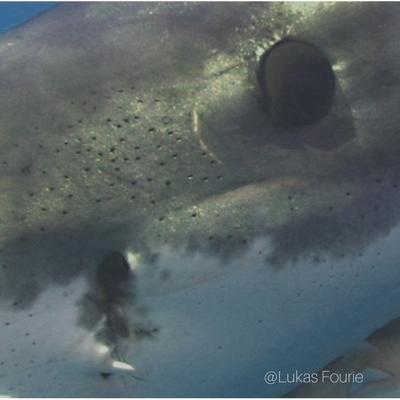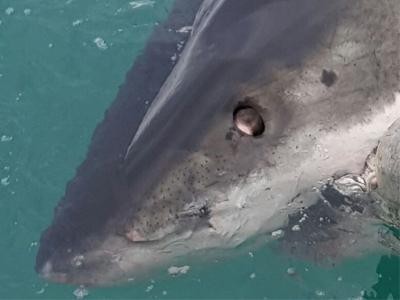Sharks don't see red -in fact they might be color blind.

What’s the view like through the eyes of a shark? That’s what some shark researchers in Australia wanted to know. They used an instrument called a microspectrophotometer to measure light-sensitive cells in the eyes of several shark species.
"Humans have three cone types that are sensitive to blue, green and red light, respectively, and by comparing signals from the different cone types we get the sensation of colour vision," according to Professor Hart, of the University of Western Australia who led the study.
However, we found that sharks have only a single cone type and by conventional reckoning, this means that they don't have colour vision. It does not necessarily mean that sharks see in black and white, but they’re certainly color-blind.
 Yum-Yum Yellow
Yum-Yum Yellow
"It has long been assumed that sharks have some sort of colour vision and indeed have a preference for certain colours."The term ‘yum, yum yellow' was coined when it was discovered, in tests by the US Navy, that some species of shark were attracted more to yellow than to other colours This raised concerns because they wanted to equip their sailors with yellow life vests to make them more visible during rescue operations.
Sharks are apex predators, and their evolutionary success is in part due to an impressive array of sensory systems, including vision. The eyes of sharks are well developed and function over a wide range of light levels. However, whilst close relatives of the sharks—the rays and chimaeras—are known to have the potential for colour vision, an evolutionary trait thought to provide distinct survival advantages.
This suggests that sharks may be cone monochromats and, therefore, potentially colour blind. Whilst cone monochromacy on land is rare, it may be a common strategy in the marine environment: many aquatic mammals (whales, dolphins and seals) also possess only a single, green-sensitive cone type. It appears that both sharks and marine mammals may have arrived at the same visual design.

Great White Shark breaching
It’s hard to know exactly what a shark sees but it appears that they’re able to discern an object by gauging its contrast against a background rather than colour per se, may be more important for object detection by sharks.
The breaching, aerial attacks, striking at very high speeds from vertically beyond, breaching the water and locking the seal in its jaws, is a manoeuvre which is indigenous to this area, but it's fascinating to know that these attacks take place mostly within the one hour before sunrise and one hour after sunset, because of the specific way the light rays strike the water surface.
This allows for the sharks to see/target the seals from beneath, while the seals above are unable to see the sharks beneath them, giving the apex predator the upper hand/"fin".
Source:
University of Western Australia
Naturwissenschaften - The Science of Nature.

